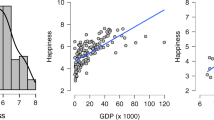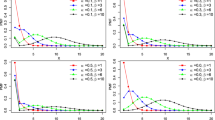Appendix
Here, we give the proofs of the theorems discussed in Sections 3 and 4. Theorem 1 can be proven by using a similar argument as the proof of Theorem 1 in Yoshida (2019). We provide a brief sketch of the proof.
Proof of Theorem 1
Let \(\boldsymbol {b}_{0}(\tau )\in \mathbb {R}^{K+p}\) be the minimizer of
$$ E[\rho_{\tau}(Y-\boldsymbol{B}(X)^{T}\boldsymbol{b})] $$
with respect to \(\boldsymbol {b}\in \mathbb {R}^{K+p}\). Since ρτ(u) is convex and QY(τ|x) is minimizer of E[ρτ(Y − u)], b0(τ) is equivalent to the best approximation of QY(τ|x). From Barrow and Smith (1978), we have
$$ \begin{array}{@{}rcl@{}} \boldsymbol{B}(x)^{T}\boldsymbol{b}_{0}(\tau)-Q_{Y}(\tau|x)=K^{-m}Q(\tau)b(x)(1+o(1)) \end{array} $$
(9)
as \(K\rightarrow \infty \) under Conditions A–B. In particular, to obtain (9), we need Conditions B1-3 to use the result of Barrow and Smith (1978). Next, we derive the difference between \(\tilde {Q}_{Y}(\tau |x)=\boldsymbol {B}(x)^{T}\tilde {\boldsymbol {b}}(\tau )\) and \(\boldsymbol {B}(x)^{T}\boldsymbol {b}_{0}(\tau )\). Define Ui = Yi −B(x)Tb0(τ) and \(a(\tau ,n)=\sqrt {n(1-\tau )}\). We let
$$ R_{n}(\tau|\boldsymbol{\delta})=\sum\limits_{i=1}^{n} \rho_{\tau}(U_{i}-\boldsymbol{B}(x_{i})^{T}\boldsymbol{\delta}/a(n,\tau))-\rho_{\tau}(U_{i}). $$
Then, the minimizer \(\tilde {\boldsymbol {\delta }}(\tau )\) of Rn is
$$ \tilde{\boldsymbol{\delta}}(\tau)=a(n,\tau)(\tilde{\boldsymbol{b}}(\tau)-\boldsymbol{b}_{0}). $$
From the result of Pollard (1991), we know that \(\tilde {\boldsymbol {\delta }}(\tau )\) is asymptotically equivalent to the minimizer of the asymptotic form of Rn(τ|δ). Therefore, we now investigate the asymptotic behavior of Rn(τ|δ). The Knight’s identity (Knight 1998) yields
$$ \begin{array}{@{}rcl@{}} \rho_{\tau}(u-v)-\rho_{\tau}(u)=-v(\tau-I(u<0))+{{\int}_{0}^{v}} \{I(u\leq s)-I(u\leq 0)\}ds \end{array} $$
and
$$ \begin{array}{@{}rcl@{}} R_{n}(\tau|\boldsymbol{\delta})=W_{n}(\tau)^{T}\boldsymbol{\delta}+G_{n}(\tau|\boldsymbol{\delta}), \end{array} $$
where
$$ \begin{array}{@{}rcl@{}} W_{n}(\tau)&\equiv&\frac{-1}{\sqrt{(1-\tau) n}}\sum\limits_{i=1}^{n} (\tau-I(Y_{i}<\boldsymbol{B}(x_{i})^{T}\boldsymbol{b}_{0}(\tau)))\boldsymbol{B}(x_{i}) \end{array} $$
and
$$ \begin{array}{@{}rcl@{}} G_{n}(\boldsymbol{\delta}|\tau)&\equiv&\sum\limits_{i=1}^{n} {\int}_{0}^{\boldsymbol{B}(x_{i})^{T}\boldsymbol{\delta}/a(n,\tau)}I(U_{i}\leq s)-I(U_{i}\leq 0)ds. \end{array} $$
We now show the asymptotic behavior of Gn(δ|τ). Writing
$$ \begin{array}{@{}rcl@{}} &&G_{n}(\boldsymbol{\delta}|\tau)\\ &&= \sum\limits_{i=1}^{n} {\int}_{0}^{\boldsymbol{B}(x_{i})^{T}\boldsymbol{\delta}/a(n,\tau)}E[I(U_{i}\leq s)-I(U_{i}\leq 0)]ds\\ &&\quad + \sum\limits_{i=1}^{n} {\int}_{0}^{\boldsymbol{B}(x_{i})^{T}\boldsymbol{\delta}/a(n,\tau)}\{I(U_{i}\leq s)-I(U_{i}\leq 0)-E[I(U_{i}\leq s)-I(U_{i}\leq 0)]\}ds\\ &&\equiv G_{1n}(\boldsymbol{\delta}|\tau)+G_{2n}(\boldsymbol{\delta}|\tau). \end{array} $$
The Taylor’s theorem yields that
$$ \begin{array}{@{}rcl@{}} &&G_{1n}(\boldsymbol{\delta}|\tau)\\ &&= \frac{1}{a(n,\tau)}\sum\limits_{i=1}^{n} {\int}_{0}^{\boldsymbol{B}(x_{i})^{T}\boldsymbol{\delta}}F_{Y}(\boldsymbol{B}(x_{i})^{T}\boldsymbol{b}_{0}(\tau) + s/a(n,\tau)|x) - F_{Y}(\boldsymbol{B}(x_{i})^{T}\boldsymbol{b}_{0}(\tau)|x_{i})ds\\ &&= \sum\limits_{i=1}^{n} {\int}_{0}^{\boldsymbol{B}(x_{i})^{T}\boldsymbol{\delta}}f_{Y}(\boldsymbol{B}(x_{i})^{T}\boldsymbol{b}_{0}(\tau)|x)\frac{s}{a(n,\tau)^{2}}ds\\ &&\quad + \sum\limits_{i=1}^{n} {\int}_{0}^{\boldsymbol{B}(x_{i})^{T}\boldsymbol{\delta}}f^{\prime}_{Y}(\boldsymbol{B}(x_{i})^{T}\boldsymbol{b}_{0}(\tau)+\theta s/(a(n,\tau))|x)\frac{s^{2}}{a(n,\tau)^{3}}ds\\ &&= \sum\limits_{i=1}^{n} \frac{f_{Y}(\boldsymbol{B}(x_{i})^{T}\boldsymbol{b}_{0}(\tau)|x)}{2n(1-\tau)}\boldsymbol{\delta}^{T}\boldsymbol{B}(x_{i})\boldsymbol{B}(x_{i})\boldsymbol{\delta}\\ &&\quad + \sum\limits_{i=1}^{n} {\int}_{0}^{\boldsymbol{B}(x_{i})^{T}\boldsymbol{\delta}}f^{\prime}_{Y}(\boldsymbol{B}(x_{i})^{T}\boldsymbol{b}_{0}(\tau)+\theta s/(a(n,\tau))|x)\frac{s^{2}}{a(n,\tau)^{3}}ds. \end{array} $$
where fY(⋅|x) is the conditional density function of Y given X = x and 𝜃 ∈ (0, 1). Here, we see that \(f_{Y}(Q_{Y}(\tau |x)|x)=\{\partial Q_{Y}(\tau |x)/\partial \tau \}^{-1}\) from τ = FY(QY(τ|x)|x) and its derivative with respect to τ. Therefore, under Conditions A1 and A4, we obtain
$$ f_{Y}(Q_{Y}(\tau|x)|x) = \gamma^{-1}H(x)^{-\gamma} (1-\tau)^{\gamma+1}L(H(x)/(1-\tau))^{-1}(1+o(1)) = O \left( \frac{1 - \tau}{Q(\tau)}\right) . $$
Similarly, we obtain
$$ f^{\prime}_{Y}(Q_{Y}(\tau|x)|x)=-\left\{\frac{\partial Q_{Y}(\tau|x)}{\partial \tau}\right\}^{-2}\frac{\partial^{2} Q_{Y}(\tau|x)}{\partial \tau^{2}}f_{Y}(Q_{Y}(\tau|x)|x). $$
and \(f^{\prime }_{Y}(Q_{Y}(\tau |x)|x)=O((1-\tau )^{2\gamma +1})\), which indicates \(|f^{\prime }_{Y}(Q_{Y}(\tau |x)|x)| < C_{1}(1-\tau )^{2\gamma +1}\) for some constant C1 > 0. From the property of B-spline approximation, we have
$$ |f_{Y}(\boldsymbol{B}(x)^{T}\boldsymbol{b}_{0}(\tau))-f_{Y}(Q_{Y}(\tau|x)|x)|=O(f^{\prime}_{Y}(Q_{Y}(\tau|x)|x)Q(\tau)K^{-m}), $$
which can be bounded by C2(1 − τ)2γ+ 1Q(τ)K−mfor a constant C2 > 0. Therefore,
$$ \begin{array}{@{}rcl@{}} &&\sum\limits_{i=1}^{n} \frac{f_{Y}(\boldsymbol{B}(x_{i})^{T}\boldsymbol{b}_{0}(\tau)}{2n(1-\tau)}\boldsymbol{\delta}^{T}\boldsymbol{B}(x_{i})\boldsymbol{B}(x_{i})\boldsymbol{\delta}\\ &&\leq \sum\limits_{i=1}^{n} \frac{f_{Y}(Q_{Y}(\tau|x)|x)|x)}{2n(1-\tau)}\boldsymbol{\delta}^{T}\boldsymbol{B}(x_{i})\boldsymbol{B}(x_{i})\boldsymbol{\delta}\\ &&+ \sum\limits_{i=1}^{n} \frac{C_{2} (1-\tau)^{2\gamma+1}Q(\tau)K^{-m}}{2n(1-\tau)}\boldsymbol{\delta}^{T}\boldsymbol{B}(x_{i})\boldsymbol{B}(x_{i})\boldsymbol{\delta}\\ &&= \frac{\gamma^{-1}Q(\tau)}{2}\boldsymbol{\delta}^{T}\left( \frac{1}{n}\sum\limits_{i=1}^{n} H(x_{i})^{-1}\boldsymbol{B}(x)\boldsymbol{B}(x)^{-1}\right)\boldsymbol{\delta}+C_{3} Q(\tau)(1-\tau)^{2\gamma}K^{-m-1} \end{array} $$
since \(n^{-1}{\sum }_{i=1}^{n} \boldsymbol {B}(x_{i})\boldsymbol {B}(x_{i})^{T}= O(K^{-1})\) for a constant C3 > 0. We can evaluate
$$ \begin{array}{@{}rcl@{}} &&\sum\limits_{i=1}^{n} {\int}_{0}^{\boldsymbol{B}(x_{i})^{T}\boldsymbol{\delta}}|f^{\prime}_{Y}(\boldsymbol{B}(x_{i})^{T}\boldsymbol{b}_{0}(\tau)+\theta s/(a(n,\tau))|x)|\frac{s^{2}}{a(n,\tau)^{3}}ds\\ &&\leq C_{4}\frac{(1-\tau)^{2\gamma+1}}{n^{1/2}(1-\tau)(1-\tau)^{1/2}} \frac{1}{n}\sum\limits_{i=1}^{n} \{\boldsymbol{B}(x_{i})^{T}\boldsymbol{\delta}\}^{3}\\ &&\leq C_{4} \frac{Q(\tau)}{K}\frac{(1-\tau)^{3\gamma}}{\{n(1-\tau)\}^{1/2}} \end{array} $$
for a constant C4 ≥ 0. Therefore, we obtain
$$ \begin{array}{@{}rcl@{}} \lim\limits_{n\rightarrow\infty}\sup\limits_{\tau\in[\tau_{1n},\tau_{2n}]} \left|\frac{K}{Q(\tau)}G_{1n}(\boldsymbol{\delta}|\tau)-\frac{1}{2}\boldsymbol{\delta}^{T}G(H^{-\gamma})\boldsymbol{\delta}\right|=0. \end{array} $$
Next, we show \(\lim _{n\rightarrow \infty }\sup _{\tau \in [\tau _{1n},\tau _{2n}]} KG_{2n}(\boldsymbol {\delta }|\tau )/Q(\tau )=0\). From the proof of Theorem 4.1 of Koenker (2005), we obtain
$$ V\left[\frac{K}{Q(\tau)}G_{2n}(\boldsymbol{\delta}|\tau)\right] \leq \frac{\max_{i}|\boldsymbol{B}(x_{i})^{T}\boldsymbol{\delta}|}{\sqrt{n(1-\tau)}} E\left[\frac{K}{Q(\tau)}G_{2n}(\boldsymbol{\delta}|\tau)\right]\leq C_{5} \frac{1}{\sqrt{n(1-\tau)}} $$
for some constant C5 > 0. Meanwhile, it is easy to show that there exists a constant M > 0 such that
$$ \begin{array}{@{}rcl@{}} \frac{K}{Q(\tau)}\frac{|\boldsymbol{B}(x_{i})^{T}\boldsymbol{\delta}|}{a(n,\tau)}&& \left|{{\int}_{0}^{1}}I(U_{i}\leq \boldsymbol{B}(x_{i})^{T}\boldsymbol{\delta}/a(n,\tau)s) - E[I(U_{i}\leq \boldsymbol{B}(x_{i})^{T}\boldsymbol{\delta}/a(n,\tau))ds\right.\\ &&\left.-{{\int}_{0}^{1}}I(U_{i}\leq 0)-I(U_{i}\leq 0)ds\right|\leq \frac{K}{Q(\tau) \sqrt{n(1-\tau)}} M \end{array} $$
since I is the indicator and E[I(Ui ≤ a)] ≤ 1. Therefore, from Bernstein’s inequality, we obtain for t > 0 that
$$ \begin{array}{@{}rcl@{}} P\left( \frac{K}{Q(\tau)}|G_{2n}(\boldsymbol{\delta}|\tau)|\geq t\right)\leq 2 \exp\left[-\frac{t^{2}}{2}\frac{\sqrt{n(1-\tau)}}{C_{5} +\frac{ M t K}{Q(\tau)}}\right]\leq 2 \exp\left[-\frac{t^{2}}{2}\frac{\sqrt{n(1-\tau)}}{C_{6}}\right] \end{array} $$
for some constant C6 ≥ C5. Putting \(t= C_{7}\{n(1-\tau _{2})\}^{-4+\nu }, \nu \in (0,4), C_{7}>0\), we have
$$ \begin{array}{@{}rcl@{}} \frac{K}{Q(\tau)}|G_{2n}(\boldsymbol{\delta}|\tau)|\leq C_{7}\{n(1-\tau_{2})\}^{-4+\nu} \end{array} $$
with probability one. This indicates that
$$ \lim\limits_{n\rightarrow\infty}\sup\limits_{\tau\in[\tau_{1},\tau_{2}]}\frac{K}{Q(\tau)}|G_{2n}(\boldsymbol{\delta}|\tau)|=0. $$
Consequently, under Conditions A1 and A4, we can show that
$$ G_{n}(\boldsymbol{\delta}|\tau) =\frac{Q(\tau)}{K}\left\{\frac{1}{2}\gamma^{-1}\boldsymbol{\delta}^{T}G(H^{-\gamma})\boldsymbol{\delta}+r_{n}(\tau)\right\}, $$
where \(\lim _{n\rightarrow \infty }\sup _{\tau \in [\tau _{1n},\tau _{2n}]} |r_{n}(\tau )|=0\).
Therefore, Rn(τ|δ) is asymptotically equivalent to
$$ W_{n}(\tau)^{T}\boldsymbol{\delta}+\frac{Q(\tau)}{2K}\gamma^{-1}\boldsymbol{\delta}G(H^{-\gamma})\boldsymbol{\delta} $$
uniformly for τ ∈ [τ1, τ2]. We define
$$ \boldsymbol{\varepsilon}=\frac{-\sqrt{K}}{\sqrt{(1-\tau) n}}\sum\limits_{i=1}^{n} (\tau-I(Y_{i}<\boldsymbol{B}(x_{i})^{T}\boldsymbol{b}_{0}(\tau)))G^{-1/2}\boldsymbol{B}(x_{i}). $$
and then get
$$ \begin{array}{@{}rcl@{}} \tilde{\boldsymbol{\delta}}(\tau)&=& K\gamma G(H^{-\gamma})^{-1}W_{n}(\tau)(1+o_{P}(1))\\ &=&\gamma K^{1/2} G(H^{-\gamma})^{-1}G^{1/2}\boldsymbol{\varepsilon}(1+o_{P}(1)), \end{array} $$
uniformly for τ ∈ [τ1, τ2].
Thus, the first assertion of Theorem 1 can be achieved to show that ε is asymptotically distributed as NK+p(0, I). From Taylor expansion, we see that \(E[I(Y_{i}<\boldsymbol {B}(x_{i})^{T}\boldsymbol {b}_{0}(\tau ))]=P(Y_{i}<\boldsymbol {B}(x_{i})^{T}\boldsymbol {b}_{0}(\tau )|x_{i})=F_{Y}(Q_{Y}(\tau |x_{i})|x_{i})+f_{Y}(Q_{Y}(\tau |x_{i})|x_{i})K^{-m}Q(\tau )b(x_{i})(1+o(1))\).
Furthermore, we have \({{\int }_{a}^{b}} b(x)\boldsymbol {B}(x)dx=O(K^{-2})\) from the properties of the Bernoulli polynomial and the B-spline basis (Aagrwal and Studden 1980). Therefore, we obtain
$$ \begin{array}{@{}rcl@{}} E[\boldsymbol{\varepsilon}]&=&O(nK^{1/2}f_{Y}(Q_{Y}(\tau|x)|x)K^{-m}Q(\tau)\{n(1-\tau)\}^{-1/2}){{\int}_{a}^{b}} b(x)\boldsymbol{B}(x)dx\\ &=&O(K^{-m-3/2}\sqrt{n(1-\tau)})\\ &\leq &O(K^{-m-3/2}\sqrt{n(1-\tau_{2})})\\ &=&o(1). \end{array} $$
That is E[ε] is dominated by the B-spline model bias. Meanwhile, the variance of ε can be calculated as \(\sup _{\tau \in [\tau _{1},\tau _{2}]}V[\boldsymbol {\varepsilon }]=I\) as \(n\rightarrow \infty \) and \(\tau _{1},\tau _{2}\rightarrow 1\). Similar to Lemma 9.6 of Chernozhukov (2005), ε is equivalent to normal with mean 0 and variance I. Consequently, since
$$ \begin{array}{@{}rcl@{}} \frac{1}{a(\tau,n)}\boldsymbol{B}(x)^{T}\tilde{\boldsymbol{\delta}}(\tau)&=& \boldsymbol{B}(x)^{T}\tilde{\boldsymbol{b}}(\tau)-\boldsymbol{B}(x)^{T}\boldsymbol{b}_{0}(\tau)\\ &=&\tilde{Q}_{Y}(\tau|x)-Q_{Y}(\tau|x)-K^{-m}Q(\tau)b(x)(1+o(1)), \end{array} $$
the intermediate order quantile estimator has an asymptotic form as
$$ \tilde{Q}_{Y}(\tau|x)-Q_{Y}(\tau|x)-b(\tau|x)=\frac{Q(\tau)K^{1/2}}{\sqrt{n(1-\tau)}}\gamma \boldsymbol{B}(x)^{T}G(H^{-\gamma})^{-1}G^{1/2}\boldsymbol{\varepsilon}(1+o_{P}(1)) $$
uniformly for τ ∈ [τ1, τ2].
From this and QY(τ|x) = h(x)Q(τ)(1 + o(1)), we obtain
$$ \begin{array}{@{}rcl@{}} \frac{\tilde{Q}_{Y}(\tau|x)}{Q_{Y}(\tau|x)}-1&=&\frac{K^{-m}b(x)}{h(x)}(1+o(1))\\ &&+\frac{K^{1/2}}{\sqrt{n(1-\tau)}}\frac{\gamma}{h(x)} \boldsymbol{B}(x)^{T}G(H^{-\gamma})^{-1}G^{1/2}\boldsymbol{\varepsilon}(1+o_{P}(1)). \end{array} $$
(10)
Hence, the MISE is
$$ \begin{array}{@{}rcl@{}} E\left[\left\{\frac{\tilde{Q}_{Y}(\tau|x)}{Q_{Y}(\tau|x)}-1\right\}^{2}\right] &=& O(K^{-m})+O\left( \frac{K}{n(1-\tau)}\right) \end{array} $$
from Lemmas 6.2 and 6.3 of Zhou et al. (1998). Finally, K = O({n(1 − τ)}1/(2m+ 1)) yields the optimal rate of convergence of MISE. This completes the second assertion. □
We next give the proof of Theorem 2. For this, we first derive the asymptotic expression of \(\hat {\gamma }(x)\).
Lemma 1
Under the same conditions as Theorem 2,
$$ \begin{array}{@{}rcl@{}} \hat{\gamma}(x)-\gamma&=& \frac{m}{m+1}k^{-m/(2m+1)}\frac{b(x)}{h(x)}\\ && -\frac{m}{m+1}k^{-m/(2m+1)}\frac{\gamma}{h(x)}\boldsymbol{B}(x)^{T} G(H^{-\gamma})^{-1}G^{1/2}\boldsymbol{\varepsilon}\\ &&\quad +o(k^{-m/(2m+1)}), \end{array} $$
whereh(x) = H(x)γ.
Proof of Lemma 1
Under the Conditions A–C, for the intermediate order quantile estimator, we obtain
$$ \begin{array}{@{}rcl@{}} &&\tilde{Q}_{Y}(\tau_{j}|x)-Q_{Y}(\tau_{j}|x)-K^{-m}Q(\tau_{j})b(x)\\ &&= \frac{Q(\tau_{j})K^{1/2}}{\sqrt{n(1-\tau_{j})}}\gamma\boldsymbol{B}(x)^{T} G(H^{-\gamma})^{-1}G^{1/2}\boldsymbol{\varepsilon}(1+o_{P}(1))\\ &&= Q(\tau_{j})\{n(1-\tau_{j})\}^{-\frac{m}{2m+1}}\gamma\boldsymbol{B}(x)^{T} G(H^{-\gamma})^{-1}G^{1/2}\boldsymbol{\varepsilon}(1+o_{P}(1)) \end{array} $$
(11)
because \(K=O(\{n(1-\tau _{j})\}^{1/(2m+1)})\) leads to the optimal order. By the Taylor expansion \(\log (1+x)=x+o(|x|)\) for |x| < 1, the EVI estimator defined in Eq. 2 can be written as
$$ \begin{array}{@{}rcl@{}} \hat{\gamma}(x)&=& \frac{1}{k-1}\sum\limits_{j=1}^{k-1} \log \frac{Q_{Y}(\tau_{j}|x)}{Q_{Y}(\tau_{k}|x)}+\frac{1}{k-1}\sum\limits_{j=1}^{k-1} \log \frac{\left\{1+\frac{\tilde{Q}_{Y}(\tau_{j}|x)-Q_{Y}(\tau_{j}|x)}{Q_{Y}(\tau_{j}|x)}\right\}}{\left\{1+\frac{\tilde{Q}_{Y}(\tau_{k}|x)-Q_{Y}(\tau_{k}|x)}{Q_{Y}(\tau_{k}|x)}\right\}}\\ &=& \frac{1}{k-1}\sum\limits_{j=1}^{k-1} \log \frac{Q_{Y}(\tau_{j}|x)}{Q_{Y}(\tau_{k}|x)}\\ &&+\frac{1}{k-1}\sum\limits_{j=1}^{k-1} \frac{\hat{Q}_{Y}(\tau_{j}|x)-Q_{Y}(\tau_{j}|x)}{Q_{Y}(\tau_{j}|x)}(1+o_{P}(1))\\ &&\quad - \frac{\tilde{Q}_{Y}(\tau_{k}|x)-Q_{Y}(\tau_{k}|x)}{Q_{Y}(\tau_{k}|x)}(1+o_{P}(1)). \end{array} $$
From the proof of Theorem 2.3 of Wang et al. (2012), we have
$$ \frac{1}{k-1}\sum\limits_{j=1}^{k-1} \log \frac{Q_{Y}(\tau_{j}|x)}{Q_{Y}(\tau_{k}|x)}=\gamma+O((n/k)^{\max\{\rho^{*},-\gamma\}})+O(k^{-1}n^{\eta} \log(k)). $$
Next, Eq. 11 yields the following:
$$ \begin{array}{@{}rcl@{}} &&\frac{\tilde{Q}_{Y}(\tau_{k}|x)-Q_{Y}(\tau_{k}|x)}{Q_{Y}(\tau_{k}|x)}\\ &&=\{n(1-\tau_{k})\}^{-m/(2m+1)}\frac{Q(\tau_{k})b(x)}{Q_{Y}(\tau_{k}|x)}\\ && \quad +\{n(1-\tau_{k})\}^{-m/(2m+1)}\frac{\gamma}{h(x)}\boldsymbol{B}(x)^{T} G(H^{-\gamma})^{-1}G^{1/2}\boldsymbol{\varepsilon}+o(k^{-m/(2m+1)})\\ &&=k^{-m/(2m+1)}\frac{b(x)}{h(x)}\\ &&\quad +k^{-m/(2m+1)}\frac{\gamma}{h(x)}\boldsymbol{B}(x)^{T} G(H^{-\gamma})^{-1}G^{1/2}\boldsymbol{\varepsilon}+o(k^{-m/(2m+1)}). \end{array} $$
Here, we used \(Q(\tau )/Q_{Y}(\tau |x) = \{h(x)\}^{-1}(1+o(1))\) and
$$ n(1-\tau_{k})=n\frac{k+[n^{\eta}]}{n+1}= k\left( 1+ \frac{[n^{\eta}]}{k}\right)\frac{n}{n+1}=k(1+o(1)) $$
from the assumption that \([n^{\eta }]/k\rightarrow 0\).
Finally, we have
$$ \begin{array}{@{}rcl@{}} &&\frac{1}{k-1}\sum\limits_{j=1}^{k-1} \frac{\hat{Q}_{Y}(\tau_{j}|x)-Q_{Y}(\tau_{j}|x)}{Q_{Y}(\tau_{j}|x)}\\ &&=\frac{1}{k-1}\sum\limits_{j=1}^{k-1} \{n(1-\tau_{j})\}^{-\frac{m}{2m+1}}\frac{Q(\tau_{j})b(x)}{Q_{Y}(\tau_{j}|x)}\\ &&\quad + \frac{1}{k-1}\sum\limits_{j=1}^{k-1} \{n(1-\tau_{j})\}^{-\frac{m}{2m+1}} \frac{\gamma}{h(x)}\boldsymbol{B}(x)^{T} G(H^{-\gamma})^{-1}G^{1/2}\boldsymbol{\varepsilon}\\ &&\quad \quad + o(k^{-m/(2m+1)})\\ &&=\frac{2m+1}{m+1}k^{-m/(2m+1)} \frac{b(x)}{h(x)}\\ &&\quad +\frac{2m+1}{m+1}k^{-m/(2m+1)} \frac{\gamma}{h(x)}\boldsymbol{B}(x)^{T} G(H^{-\gamma})^{-1}G^{1/2}\boldsymbol{\varepsilon}+o(k^{-m/(2m+1)}). \end{array} $$
Here, we used the fact that
$$ \begin{array}{@{}rcl@{}} && \frac{1}{k-1}\sum\limits_{j=1}^{k-1}\left( n(1-\tau_{j})\right)^{-m/(2m+1)}\\ &&= \frac{1}{k-1}\sum\limits_{j=1}^{k-1}k^{-m/(2m+1)}\left( \frac{j+[n^{\eta}]}{k+1}\right)^{-m/(2m+1)}(1+o(1))\\ &&=k^{-m/(2m+1)} {{\int}_{0}^{1}} u^{-m/(2m+1)}du(1+o(1))\\ &&=\frac{2m+1}{m+1}k^{-m/(2m+1)} (1+o(1)). \end{array} $$
Consequently, \(\hat {\gamma }(x)\) can be expressed as
$$ \begin{array}{@{}rcl@{}} \hat{\gamma}(x)&=&\gamma+\frac{m}{m+1}k^{-m/(2m+1)}\frac{b(x)}{h(x)}\\ && +\frac{m}{m+1}k^{-m/(2m+1)}\frac{\gamma}{h(x)}\boldsymbol{B}(x)^{T} G(H^{-\gamma})^{-1}G^{1/2}\boldsymbol{\varepsilon}\\ &&\quad +O((n/k)^{\max\{\rho^{*},-\gamma\}})+O(k^{-1}n^{\eta} \log(k))+o(k^{-m/(2m+1)})\\ &=& \gamma+\frac{2m+1}{m+1}k^{-m/(2m+1)}\frac{b(x)}{h(x)}\\ && +\frac{2m+1}{m+1}k^{-m/(2m+1)}\frac{\gamma}{h(x)}\boldsymbol{B}(x)^{T} G(H^{-\gamma})^{-1}G^{1/2}\boldsymbol{\varepsilon}\\ &&\quad +o(k^{-m/(2m+1)}) \end{array} $$
under the assumptions of Theorem 2, which completes the proof. □
Proof of Theorem 2
By the definition of the extrapolated estimator, we obtain
$$ \begin{array}{@{}rcl@{}} \frac{\hat{Q}_{Y}(\tau|x)}{Q_{Y}(\tau|x)}&=&\left( \frac{1-\tau_{I}}{1-\tau}\right)^{\gamma}\left( \frac{1-\tau_{I}}{1-\tau}\right)^{\hat{\gamma}(x)-\gamma}\frac{\tilde{Q}_{Y}(\tau_{I}|x)}{Q_{Y}(\tau_{I}|x)}\frac{Q_{Y}(\tau_{I}|x)}{Q_{Y}(\tau|x)} \end{array} $$
for the extreme order quantile τ and the intermediate order quantile τI. Thus, the asymptotic form of \(\hat {Q}_{Y}(\tau |x)\) can be represented by those of \(\hat {\gamma }(x)-\gamma \), \(\tilde {Q}_{Y}(\tau _{I}|x)\) and QY(τI|x)/QY(τ|x). Firstly, from Theorem 1, we have
$$ \begin{array}{@{}rcl@{}} \frac{\tilde{Q}_{Y}(\tau_{I}|x)}{Q_{Y}(\tau_{I}|x)}&=&1+\frac{\tilde{Q}_{Y}(\tau_{I}|x)-Q_{Y}(\tau_{I}|x)}{Q_{Y}(\tau_{I}|x)} \\ &=&1+\{n(1-\tau_{I})\}^{-\frac{m}{2m+1}}\frac{b(x)}{h(x)}\\ &&+\{n(1-\tau_{I})\}^{-\frac{m}{2m+1}}\frac{\gamma}{h(x)}\boldsymbol{B}(x)^{T} G(H^{-\gamma})G^{1/2}\boldsymbol{\varepsilon}\\ &&\quad +o\left( \{n(1-\tau_{I})\}^{-\frac{m}{2m+1}}\right) . \end{array} $$
(12)
Secondly, since QY(τ|x) = UY(1/(1 − τ)|x), the second-order condition of UY(⋅|x) is
$$ \begin{array}{@{}rcl@{}} &&\frac{U_{Y}(\frac{1}{1-\tau_{I}}|x)}{U_{Y}\left( \frac{1}{1-\tau}|x\right)}\\ &&= \frac{U_{Y}(\frac{1}{1-\tau_{I}}|x)}{U_{Y}\left( \frac{1-\tau_{I}}{1-\tau}\frac{1}{1-\tau_{I}}|x\right)}\\ &&= \left[ \left( \frac{1 - \tau_{I}}{1 - \tau}\right)^{\gamma} \left\{ 1+A^{*}(1/(1-\tau_{I})|x)\frac{\left( \frac{1-\tau_{I}}{1-\tau}\right)^{\rho^{*}} - 1}{\rho^{*}}\right\}+o(A^{*}(1/(1-\tau_{I})|x)) \right]^{-1}\\ &&=\left( \frac{1 - \tau_{I}}{1 - \tau}\right)^{-\gamma}\left\{ 1-A^{*}(1/(1-\tau_{I})|x)\frac{\left( \frac{1-\tau_{I}}{1-\tau}\right)^{\rho^{*}}-1}{\rho^{*}}+o(A^{*}(1/(1-\tau_{I})|x))\right\}. \end{array} $$
Therefore, under \(A^{*}(1/(1-\tau _{I}))\leq A^{*}(1/(1-\tau _{k}))=A^{*}(n/k|x)(1+o(1))=O((n/k)^{\rho ^{*}})=o(k^{-m/(2m+1)})\), we get
$$ \begin{array}{@{}rcl@{}} \left( \frac{1 - \tau_{I}}{1 - \tau}\right)^{\gamma}\frac{Q_{Y}(\tau_{I}|x)}{Q_{Y}(\tau|x)} &=& 1-A^{*}(1/(1 - \tau_{I})|x)\frac{\left( \frac{1-\tau_{I}}{1-\tau}\right)^{\rho^{*}} - 1}{\rho^{*}}+o(A^{*}(1/(1 - \tau_{I})|x))\\ &=& 1+o(k^{-m/(2m+1)}). \end{array} $$
(13)
Thirdly, from Lemma 1, for a(τ, τI) = (1 − τI)/(1 − τ), we have the following:
$$ \begin{array}{@{}rcl@{}} &&\left( a(\tau,\tau_{I})\right)^{\hat{\gamma}(x)-\gamma}\\ &&=\exp[(\hat{\gamma}(x)-\gamma)\log a(\tau,\tau_{I})]\\ &&=1+ (\hat{\gamma}(x)-\gamma)\log a(\tau,\tau_{I}) +o(k^{-m/(2m+1)}\log(a(\tau,\tau_{I})))\\ &&=1+\frac{m}{m+1}k^{-m/(2m+1)}\log\left( \frac{1-\tau_{I}}{1-\tau}\right)\frac{b(x)}{h(x)}\\ &&\quad +\frac{m}{m+1}k^{-m/(2m+1)}\log\left( \frac{1-\tau_{I}}{1-\tau}\right)\frac{\gamma}{h(x)}\boldsymbol{B}(x)^{T} G(H^{-\gamma})^{-1}G^{1/2}\boldsymbol{\varepsilon}\\ &&\quad\quad +o\left( k^{-m/(2m+1)}\log\left( \frac{1-\tau_{I}}{1-\tau}\right)\right). \end{array} $$
(14)
Here, we notice that
$$ \begin{array}{@{}rcl@{}} &&\sup_{\tau\in[\tau_{E,1},\tau_{E,2}]}\log\left( \frac{1-\tau_{I}}{1-\tau}\right)o(k^{-n/(2m+1)})\\ &&\leq k^{-n/(2m+1)} \log\left( \frac{1-\tau_{I}}{1-\tau_{E,2}}\right)o(1)\\ &&\leq k^{-n/(2m+1)} \log\left( \frac{1-\tau_{I}}{1-\tau_{E,1}}\right)\frac{\log(n(1-\tau_{I}))-\log(n(1-\tau_{E,2}))}{\log(n(1-\tau_{I}))-\log(n(1-\tau_{E,1}))}o(1)\\ &&=o\left( k^{-n/(2m+1)} \log\left( \frac{1-\tau_{I}}{1-\tau_{E,1}}\right)\right). \end{array} $$
Thus, Eq. 14 holds uniformly for τ ∈ [τE,1, τE,2]. Combining (12), (13) and (14), we obtain
$$ \begin{array}{@{}rcl@{}} &&\frac{\hat{Q}_{Y}(\tau|x)}{Q_{Y}(\tau|x)}\\ &&= \left[ 1+\{n(1-\tau_{I})\}^{-\frac{m}{2m+1}}\frac{b(x)}{h(x)}+\{n(1 - \tau_{I})\}^{-\frac{m}{2m+1}}\frac{\gamma}{h(x)}\boldsymbol{B}(x)^{T} G(H^{-\gamma})G^{1/2}\boldsymbol{\varepsilon}\right]\\ &&\times \left[1+o(k^{-m/(2m+1)})\right]\\ &&\quad \times \left[1+\frac{m}{m+1}k^{-m/(2m+1)}\log\left( \frac{1-\tau_{I}}{1-\tau}\right)\frac{b(x)}{h(x)}\right.\\ &&\quad \quad \left. +\frac{m}{m+1}k^{-m/(2m+1)}\log\left( \frac{1-\tau_{I}}{1-\tau}\right)\frac{\gamma}{h(x)}\boldsymbol{B}(x)^{T} G(H^{-\gamma})^{-1}G^{1/2}\boldsymbol{\varepsilon}\right]\\ &=& 1 +\left\{\{n(1-\tau_{I})\}^{-\frac{m}{2m+1}}+\frac{m}{m+1}k^{-\frac{m}{2m+1}}\log\left( \frac{1-\tau_{I}}{1-\tau}\right)\right\}\frac{b(x)}{h(x)}\\ &&+ \left\{\{n(1-\tau_{I})\}^{-\frac{m}{2m+1}}+\frac{m}{m+1}k^{-\frac{m}{2m+1}}\log\left( \frac{1-\tau_{I}}{1-\tau}\right)\right\}\\ &&\quad \quad \times \frac{\gamma}{h(x)}\boldsymbol{B}(x)^{T} G(H^{-\gamma})^{-1}G^{1/2}\boldsymbol{\varepsilon}\\ &&\quad \quad +o(\{n(1-\tau_{I})\}^{-\frac{m}{2m+1}})+o(k^{-\frac{m}{2m+1}}\log\{(1-\tau_{I})/(1-\tau)\}), \end{array} $$
(15)
uniformly for \(\tau \in [\tau _{E,1},\tau _{E,2}]\), which completes the proof of the first assertion. From this, the asymptotic order of the squared bias and the variance of \(\hat {Q}_{Y}(\tau |x)/Q_{Y}(\tau |x)\) are similarly given by
$$ O\left( \{n(1-\tau_{I})\}^{-\frac{2m}{2m+1}}\right) +O\left( k^{-\frac{2m}{2m+1}}\log^{2}\left( \frac{1-\tau_{I}}{1-\tau}\right)\right). $$
Thus, we have also proved the second assertion. □
Proof of Theorem 3
The width of the confidence band is
$$ 2d_{\alpha}(\tau)||\ell(\tau|x)|| $$
for the intermediate order quantile τ. From Theorem 1, ||ℓ(τ|x)|| is the standard deviation of the estimator \(\tilde {Q}_{Y}(\tau |x)\), hence, we have ||ℓ(τ|x)|| = O((1 − τ)−γ{n(1 − τ)}−m/(2m+ 1)) under the assumptions of Theorem 3. What remains is to verify that
$$ d_{\alpha}(\tau)=O(\sqrt{\log(K^{2})})=O(\sqrt{\log[\{n(1-\tau)\}^{2/(2m+1)}]}). $$
The normal distribution is light tail and hence 1 −Φ(dα(τ)) = o(1) as \(n\rightarrow \infty \) and \(\tau \rightarrow 1\). Therefore, dα(τ) is asymptotically equivalent to
$$ \sqrt{\log[2(\alpha\pi)^{-1}\nu(\tau)^{2}]}(1+o(1)), $$
and hence it is sufficient to show that ν(τ) = O(K). By definition,
$$ \begin{array}{@{}rcl@{}} \nu(\tau)&=&{{\int}_{a}^{b}} \left|\left|\frac{d}{dx}\frac{\boldsymbol{\ell}(\tau|x)}{||\boldsymbol{\ell}(\tau|x)||}\right|\right| \\ &=&{{\int}_{a}^{b}} \frac{\sqrt{||\boldsymbol{\ell}(\tau|x)||^{2}||\boldsymbol{\ell}^{(1)}(\tau|x)||^{2}-\{\boldsymbol{\ell}(\tau|x)^{T}\boldsymbol{\ell}^{(1)}(\tau|x)\}^{2}}}{||\boldsymbol{\ell}(\tau|x)||^{2}}dx\\ &=&{{\int}_{a}^{b}} \sqrt{\frac{||\boldsymbol{\ell}(\tau|x)||^{2}||\boldsymbol{\ell}^{(1)}(\tau|x)||^{2}-\{\boldsymbol{\ell}(\tau|x)^{T}\boldsymbol{\ell}^{(1)}(\tau|x)\}^{2}}{||\boldsymbol{\ell}(\tau|x)||^{2}||\boldsymbol{\ell}(\tau|x)||^{2}}}dx, \end{array} $$
where ℓ(1)(τ|x) = dℓ(τ|x)/dx. We rewrite the B-spline vector B(x) as \(\boldsymbol {B}^{[p]}(x)=(B_{1}^{[p]}(x),\cdots ,B_{K+p}^{[p]}(x))^{T}\). By the differential property of the B-spline function, we have
$$ \begin{array}{@{}rcl@{}} \boldsymbol{\ell}^{(1)}(\tau|x)^{T}&=&\frac{Q(\tau)K^{1/2}}{\sqrt{n(1-\tau)}}\frac{d}{dx}\boldsymbol{B}^{[p]}(x)^{T} G(H^{-\gamma})^{-1}G^{1/2}\\ &=&\frac{Q(\tau)K^{1/2}}{\sqrt{n(1-\tau)}}K^{*}\boldsymbol{B}^{[p-1]}(x)^{T}D_{1} G(H^{-\gamma})^{-1}G^{1/2}, \end{array} $$
where D1 is first-order difference matrix given by the (K + p − 1) × (K + p) matrix having
$$ \begin{array}{@{}rcl@{}} D_{1}= \left[ \begin{array}{ccccc} 1&-1&0&\cdots&0\\ 0&1&-1&\cdots&0\\ \vdots&\ddots&\ddots&\ddots&\vdots\\ 0&\cdots&0&1&-1 \end{array} \right]. \end{array} $$
Therefore, we obtain
$$ \frac{||\boldsymbol{\ell}^{(1)}(\tau|x)||^{2}}{||\boldsymbol{\ell}(\tau|x)||^{2}}= O\left( K^{2}\right) $$
and
$$ \frac{\boldsymbol{\ell}(\tau|x)^{T}\boldsymbol{\ell}^{(1)}(\tau|x)}{||\boldsymbol{\ell}(\tau|x)||^{2}}= O\left( K^{2}\right). $$
These results prove that ν(τ) = O(K), which completes the proof. □
Proof of Theorem 4
To obtain the result of the theorem, we need to show the asymptotic order of
$$ \frac{||\boldsymbol{\ell}^{(1)}(\tau|x)||^{2}}{||\boldsymbol{\ell}(\tau|x)||^{2}} $$
and
$$ \frac{\boldsymbol{\ell}(\tau|x)^{T}\boldsymbol{\ell}^{(1)}(\tau|x)}{||\boldsymbol{\ell}(\tau|x)||^{2}}. $$
Therefore, we consider the derivative of ℓ(τ|x).
From the proof of Theorem 2, we obtain
$$ \begin{array}{@{}rcl@{}} \frac{\hat{Q}_{Y}(\tau|x)}{Q_{Y}(\tau|x)}&=&\left[1+\frac{\tilde{Q}_{Y}(\tau_{I}|x)-Q_{Y}(\tau_{I}|x)}{Q_{Y}(\tau_{I}|x)}\right]\\ &&\times [1+A^{*}(1/(1-\tau_{I})|x)+o(A^{*}(1/(1-\tau_{I})|x))]\\ &&\quad \times \left[ 1+ (\hat{\gamma}(x)-\gamma)\log\{(1-\tau_{I})/(1-\tau)\}(1+o(1))\right]. \end{array} $$
First, \(A^{*}(t|x)=\gamma d^{*}(x)t^{\rho ^{*}}\), hence, \(d A^{*}(t|x)/d x=O(t^{\rho ^{*}})\). From this, the A∗ term becomes negligible order. Therefore, we omit this term and obtain the following
$$ \begin{array}{@{}rcl@{}} \hat{Q}_{Y}(\tau|x)-Q_{Y}(\tau|x)&=&\tilde{Q}_{Y}(\tau_{I}|x)-Q_{Y}(\tau_{I}|x)\\ &&+Q_{Y}(\tau|x)(\hat{\gamma}(x)-\gamma)\log\left( \frac{1-\tau_{I}}{1-\tau}\right) +o(k^{-m/(2m+1)}) \end{array} $$
By the result of Theorem 1, we obtain
$$ \tilde{Q}_{Y}(\tau_{I}|x)-Q_{Y}(\tau_{I}|x)-\{n(1-\tau_{I})\}^{-m/(2m+1)}Q(\tau_{I})b(x)=\boldsymbol{\ell}_{1}(x)^{T}\boldsymbol{\varepsilon}(1+o_{P}(1)), $$
where
$$ \boldsymbol{\ell}_{1}(\tau_{I}|x)^{T}=\{n(1-\tau_{I})\}^{-\frac{m}{2m+1}}Q(\tau)\gamma\boldsymbol{B}(x)^{T} G(H^{-\gamma})^{-1}G^{1/2}. $$
Similar to the proof of Theorem 3, we have
$$ \boldsymbol{\ell}^{(1)}_{1}(\tau_{I}|x)^{T}=\{n(1-\tau_{I})\}^{-\frac{m-1}{2m+1}}Q(\tau)\gamma\boldsymbol{B}(x)^{T}D_{1} G(H^{-\gamma})^{-1}G^{1/2} $$
because \(K=O(\{n(1-\tau _{I})\}^{1/(2m+1)})\). Similarly, from the result of Lemma 1,
$$ \hat{\gamma}(x)-\gamma-N(n,k,\tau_{I})b(x)=\boldsymbol{\ell}_{2}(x)^{T}\boldsymbol{\varepsilon}(1+o_{P}(1)), $$
where
$$ \boldsymbol{\ell}_{2}(\tau|x)^{T}=\frac{1}{k-1}\sum\limits_{j=1}^{k-1}\{n(1-\tau_{j})\}^{-\frac{m}{2m+1}}Q(\tau)\gamma \boldsymbol{B}(x)^{T}G(H^{-\gamma})^{-1}G^{1/2}. $$
The derivative of ℓ2(τ|x) can be calculated as
$$ \begin{array}{@{}rcl@{}} \boldsymbol{\ell}_{2}^{(1)}(\tau|x)^{T}=\frac{1}{k-1}\sum\limits_{j=1}^{k-1}\{n(1-\tau_{j})\}^{-\frac{(m-1)}{2m+1}}Q(\tau)\gamma \boldsymbol{B}(x)^{T}D_{1}G(H^{-\gamma})^{-1}G^{1/2}. \end{array} $$
Then, we obtain
$$ \frac{1}{k-1}\sum\limits_{j=1}^{k-1}\{n(1-\tau_{j})\}^{-\frac{m-1}{2m+1}}=\frac{2m+1}{m+2}k^{-\frac{m-1}{2m+1}}(1+o(1)). $$
Hence,
$$ \boldsymbol{\ell}_{2}^{(1)}(\tau|x)^{T}=\frac{2m+1}{m+2}k^{-\frac{m-1}{2m+1}}Q(\tau)\gamma \boldsymbol{B}(x)^{T}D_{1}G(H^{-\gamma})^{-1}G^{1/2}. $$
Since
$$ \boldsymbol{\ell}(\tau|x)=\boldsymbol{\ell}_{1}(\tau|x)+\boldsymbol{\ell}_{2}(\tau|x), $$
we have
$$ \frac{||\boldsymbol{\ell}^{(1)}(\tau|x)||^{2}}{||\boldsymbol{\ell}(\tau|x)||^{2}}=O\left( \{n(1-\tau_{I})\}^{\frac{1}{2m+1}}\right)+O\left( k^{\frac{1}{2m+1}}\log\left( \frac{1-\tau_{I}}{1-\tau}\right)\right) $$
and
$$ \frac{\boldsymbol{\ell}(\tau|x)^{T}\boldsymbol{\ell}^{(1)}(\tau|x)}{||\boldsymbol{\ell}(\tau|x)||^{2}}=O\left( \{n(1-\tau_{I})\}^{\frac{1}{2m+1}}\right)+O\left( k^{\frac{1}{2m+1}}\log\left( \frac{1-\tau_{I}}{1-\tau}\right)\right). $$
The remainder is similar to the proof of Theorem 3. Therefore, we have proved Theorem 4. □




